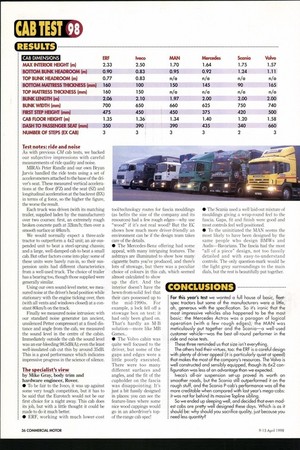C=1253 Test notes: ride and noise As with previous CM
Page 38

If you've noticed an error in this article please click here to report it so we can fix it.
cab tests, we backed our subjective impressions with careful measurements of ride quality and noise.
MIRA's Peter Randle and our own Bryan Jarvis handled the ride tests using a set of accelerometers attached to the base of the driver's seat. These measured vertical accelerations at the floor (FZ) and the seat (SZ) and longitudinal acceleration at the backrest (BX) in terms of g force, so the higher the figure, the worse the result.
Each truck was driven (with its matching trailer, supplied laden by the manufacturer) over two courses: first, an extremely rough broken concrete path at 32km/h; then over a smooth surface at 48km/h.
We would normally expect a three-axle tractor to outperform a 4x2 unit; an air-suspended unit to beat a steel-sprung chassis; and a large, well-damped cab to beat a small cab. But other factors come into play: some of these units were barely run-in, so their suspension units had different characteristics from a well-used truck. The choice of trailer has a bearing too, though those supplied were generally similar.
Using our own sound-level meter, we measured noise at the driver's head position while stationary with the engine ticking over, then (with all vents and windows closed) at a constant 80km/h on the track.
Finally we measured noise intrusion: with our standard noise generator (an ancient, unsilenced Petter compressor) at a fixed distance and angle from the cab, we measured the sound level in the centre of the cabin. Immediately outside the cab the sound level was an ear-bleeding 98.5dB(A); even the least well-insulated cab cut this by around 35dB. This is a good performance which indicates impressive progress in the science of silence.
The specialist's view by Mike Gray, body trim and hardware engineer, Rover.
• To be fair to the Iveco, it was up against some very tough competition, but it has to be said that the Eurotech would not be our first choice for a night away. This cab does its job, but with a little thought it could be made to do it much better.
• ERF, working with much lower-cost tool/technology routes for fascia mouldings (as befits the size of the company and its resources) had a few rough edges—why use "wood" if it's not real wood? But the EC shows how much more driver-friendly an environment can be if the design team takes care of the details.
• The Volvo cabin was quite well focused to the driver, but some of the gaps and edges were a little poorly executed. There were too many different surfaces and angles, and the fit of the cupholder on the fascia was disappointing. It's just a bit fussily designed in places: you can see the feature-lines where some nice wood cappings would go in an iiberdriver's topof the-range cab spec! • The Scania used a well laid-out mixture of mouldings giving a wrap-round feel to the fascia. Gaps, fit and finish were good and most controls feel well positioned.
• To the uninitiated the MAN seems the most likely to have been designed by the same people who design BMWs and Audis—Bavarians. The fascia had the most "all of a piece" design, not too fussily detailed and with easy-to-understand controls. The only question-mark would be the light grey surroundings to the main dials, but the rest is beautifully put together.
CONCLUSIONS For this year's test we wanted a full house of basic, fleetspec tractors but some of the manufacturers were a little, ah, generous with the specification. So it's ironic that the most impressive vehicles also happened to be the most basic: the Mercedes Actros was a paragon of logical operation (with a few rough edges); the MAN was meticulously put together and the Scania—a well-used customer vehicle—was the best all-round performer in the ride and noise tests.
These three reminded us that size isn't everything. The others had their virtues, too: the ERF is a careful design with plenty of driver appeal (it is particularly quiet at speed) that makes the most of the company's resources. The Volvo is well constructed and sensibly equipped, though its 6x2 configuration was less of an advantage than we expected. lveco's all-air suspension set-up proved its worth on smoother roads, but the Scania still outperformed it on the rough stuff, and the Scania P-cab's performance was all the more creditable when compared with last year's mega-cabs: it was not far behind its massive Topline sibling. So we ended up sleeping well, and decided that even modest cabs are pretty well designed these days. Which is as it should be: why should you sacrifice quality, just because you need less quantity?










































































































